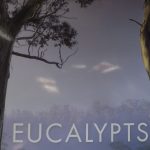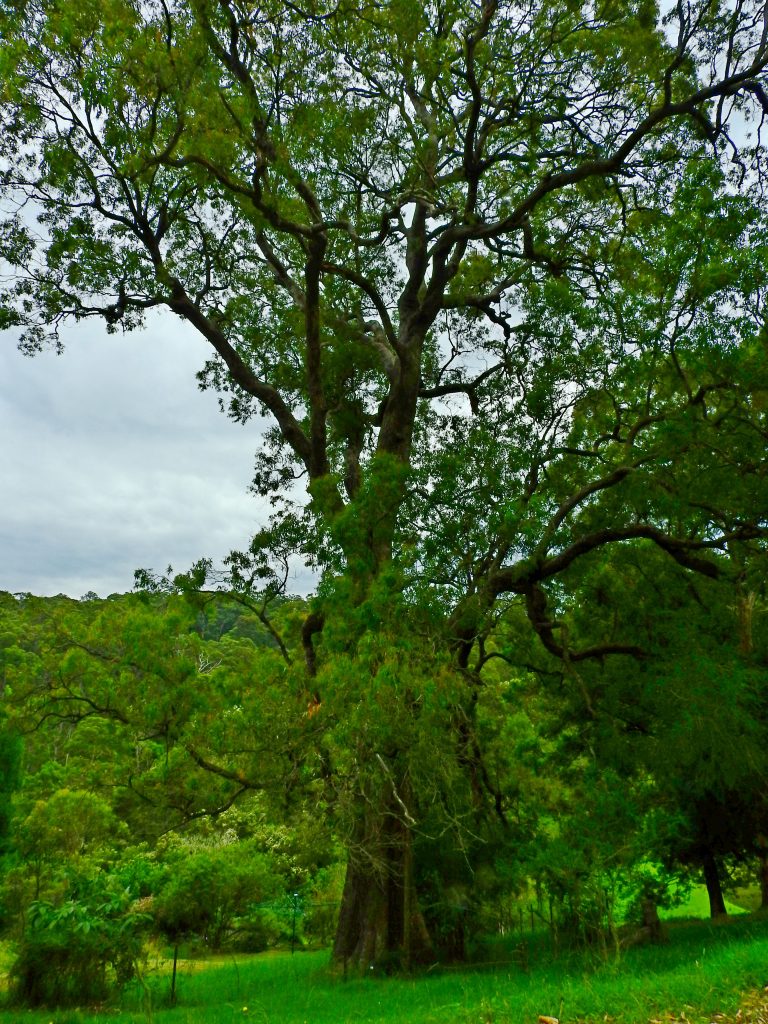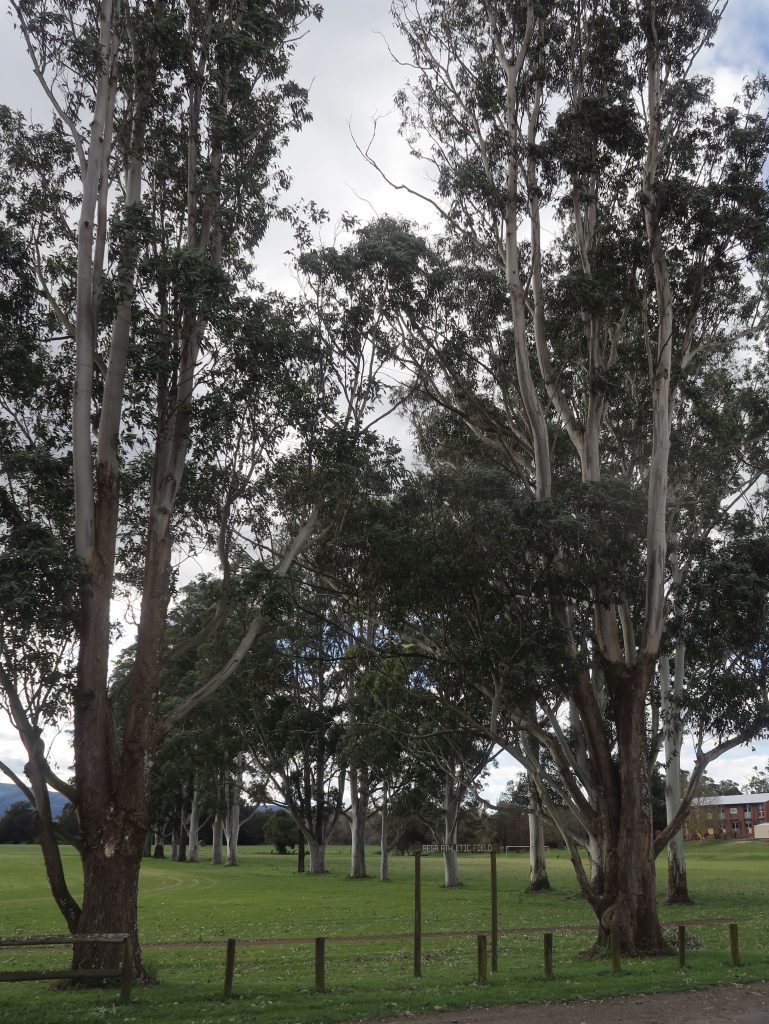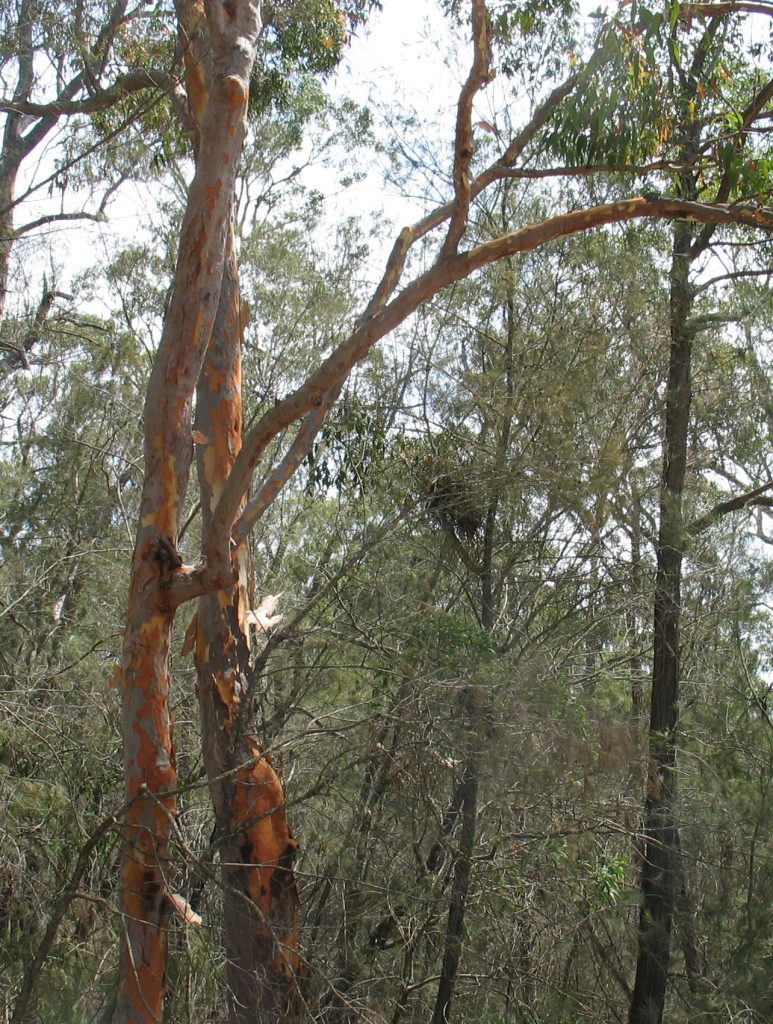
There are over 900 species of Eucalyptus in Australia and identifying which species you are looking at can often be very difficult. In November 2022, a Eucalyptus identification workshop was hosted at the Tarraganda Hall. During this workshop, a local botanist described various methods to identify the Eucalyptus species in the Bega Valley area and beyond, including habitat, bark, leaves and fruit. Note that the term Eucalyptus used here includes three genera, Eucalyptus, Corymbia and Angophora species. Below are the images used in the workshop and the accompanying notes which provide a very useful tool in assisting with the identification of Eucalyptus species in the Bega Valley and Eurobodalla area.
Presentation – Part 1 (General)






















































































































Presentation – Part 2 (Common Species)




















































































Presentation – Part 3 (Bega Valley Rare Species)















































Presentation – Part 4 (Eurobodalla Rare Species)






























Eucalyptus Identification Presentation 2022
Note: “Eucalypt” for this workshop includes Apples (Angophora species) and Bloodwoods (Corymbia species). The latter used to be in the genus Eucalyptus, but were regarded as sufficiently different to transfer to their own genus in 1995. Older books will still refer to them as Eucalyptus.
Some small tree Wattles (Acacia species) have leaves and bark quite similar to those of a eucalypt, though obviously readily distinguishable if they have buds, flowers or seed pods visible at the time. Distinguishing features of the leaves are the possible presence of a gland (a paler swelling) along one edge of the leaf close to the base, or having parallel venation , i.e there is more than one visible vein running the length of the leaf, with fainter ones running parallel to and between them, unlike eucalypts which have a single midrib (obvious central vein) and fainter veins running from it towards the leaf margin, just inside which is an intramarginal vein. Most eucalypt foliage has visible translucent pale oil dots if held up to the light. These carry the oils that give eucalypt foliage its smell. Different species have these developed to a greater or lesser extent, and consequently smell more or less strongly when the leaf is crushed. Angophora leaves have little or no smell and less obvious oil dots. Wattles may have pale areas in the leaf at vein junctions but they will not be circular oil dots.
EUCALYPT IDENTIFICATION FEATURES
1. Habitat
Many eucalypt species are not fussy about where they grow and can be found in many parts of the landscape. Others have quite specific habitat preferences, and learning these can help decide what species you are looking at in a particular location. Examples of local habitat types are:
- Sandy soils close to beaches, or further inland derived from sandstone
- Coastal forests on clay soils derived from Ordovician siltstone
- River-flats or creek banks on fertile alluvial soils, or other coastal wet areas like lagoon margins
- The farming areas, mostly on more fertile granite-derived soils, and wetter areas like gullies within them
- Hinterland and coastal ranges, steep, usually on sedimentary rocks with less fertile shallow soils, and wetter areas like gullies within them
- The top of the escarpment, at altitudes of between 600 to 1100m, generally flatter than the ranges, with a higher rainfall. Some local species are only found here, and are not covered in this workshop. Others are common to the coast and the escarpment, but might be more restricted in location on the coast due to preferring wetter conditions.
2. Bark
Bark is the most visible feature and often the best for narrowing the choices in making an ID. Smooth-barked species shed their bark annually, sometimes in plates, sometimes in long ribbons, and the latter can hang up in the branches. Some smooth-barked species have scribbles in the bark made by insect larvae tunnelling under the bark. On the coast these are all species with rough bark at the base of the tree so you have to look up to the upper trunk or branches to see them. Most smooth barked species quite often have a short stocking of rough bark at the base.
Rough bark comes in a variety of forms. The Red Bloodwood (Corymbia gummifera) has tessellated bark (tesserae = tiles in Latin, with the bark sections in tile-like chunks. Bangalay (E. botryoides) bark can also look tessellated. Boxes and most peppermints have finely fibrous pale grey bark. Ironbarks have deeply furrowed hard bark which is very difficult to break chunks off by hand. Stringybarks have the rough bark in longer strips, less deeply furrowed than ironbark and quite easy to pull off.
Rough bark can extend a variable distance up the trunk. Species with just a stocking of rough bark at the base and a smooth upper trunk are sometimes called half barks. Rough bark can extend right to the small branches (e.g. Rough-barked Apple), or the branches and part of the trunk might be smooth (e.g. stringybarks, boxes).
3. Leaves
Adult leaves are not very useful for eucalypt ID, although some clues can be obtained from whether they are large or small, and held drooping, or more horizontal to produce a denser looking crown from below. But the adult leaves of most species look very similar. Exceptions are Angophora foliage, in which the leaves are always in opposite pairs on the stem (alternate for adult euc foliage), and the odd species in which leaves are very narrow (e.g. E. elata, E. viminalis) or very broad (E. baueriana).
Fortunately the juvenile foliage produced by young plants, or in epicormic shoots produced on the trunk or branches of mature trees after loss of foliage to stresses such as drought, insect attack or fire, is often very distinctive and species specific. It is often opposite for few to many leaf pairs, and often sessile (attached directly to the stem, lacking a leaf stalk, or “petiole”). It is usually broader than adult foliage and in some species it is covered in a waxy bloom (“glaucous”), e.g. E. maidenii. Stringybark juvenile foliage is covered in short stellate (star-like clusters) hairs. Looking for young plants close to an adult tree can help to determine what the adult tree is, although in a forest of mixed species it can be hard to determine which adults correlate with which saplings or seedlings. Epicormic shoots on the adult plant are safer, since it is obvious which plant they belong to.
4. Flowers, buds, fruits
Flowers are similarly unhelpful, as all look very much the same, composed of a cluster of stamens (the pollen bearing structures) with no petals. Angophora is an exception as it retains small petals at the base of the stamens but they are not very obvious. The usual arrangement is one bud cluster in the axil of each leaf, but Angophora, bloodwoods and boxes tend to have large sprays of buds held near the tips of the branches, so their flowering is much more visible. Most eucalypts don’t flower very regularly. Bloodwoods and Angophora are fairly reliable annual flowerers, true eucalypts less so.
Buds are often formed a long time before the plant flowers and after flowering the fruits are held almost indefinitely in many species, so they are much easier to find, and more distinctive in appearance than the flowers. Binoculars can be useful to get a look at those up in the crown, or the ground under the tree can be searched to find fallen ones. Again, if more than one tree species is present the buds or fruits found under a particular tree may not belong to it, but could have blown across from a neighbour, so some caution should be exercised.
The number of buds in a cluster is species specific: 7 is the most common number, but 3’s, 15’s and in E. elata, up to 30 buds can occur. Some buds may drop off, but will leave a scar so the original total number per cluster can still be determined. Bud clusters are attached to the stem via a peduncle which may be short or long, round or flat in cross-section. Each individual bud may have its own stalk or pedicel, such buds being termed pedicillate, or if they have none, they are called sessile. If the buds are either pedicillate or sessile, so will the fruits be.
All eucalypts have a cap (operculum) at the top of the bud which lifts off when the flower is ready to open. Some have two caps, with one falling first to leave a scar around the upper half of the bud, before the second cap falls. Descriptions may mention whether a scar is present or not.
Fruits (“gumnuts”) vary widely in size, shape and degree of woodiness. In Angophora they are usually not woody and have ribs terminating in points around the rim. In bloodwoods (Corymbia), they are large and woody and urn shaped, with a rounded lower part, constricted below a flared rim. Stringybarks are mostly hemispherical in shape.
When the fruit is ready to release seed it opens by valves. There are usually 4 valves, but occasionally 3 (E. fastigata) or 5-6 (E. bosistoana). Valves can be held at or below rim level on the fruit, or protrude above it (“exsert”). An example with exsert valves is Forest Red Gum (E. tereticornis). Before the valves open such fruits look domed in the upper half.
BEGA VALLEY SPECIES (not an exhaustive list)
Apples (Angophora)
Rough-barked Apple or Apple Gum (A. floribunda) – common in a lot of forest types, most conspicuous in the remnant grassy woodland of the farming areas. Rough bark right to branch tips, branches often gnarled, adult leaves opposite, non-smelly, finely veined with veins at near 90 degrees to the midrib. Flowers regularly, Dec-Jan.
Bloodwoods (Corymbia)
Red Bloodwood (C. gummifera) mostly found on sandy soils, but not invariably. Tessellated reddish brown bark, big, woody urn-shaped fruits. Similar in general appearance to Rough-barked Apple, but leaves are not opposite, though similar in general appearance (texture, colour, close-packed veins at near 90 degrees to midrib). Doesn’t have such gnarly branches as Apple. Flowers late summer to autumn.
Spotted Gum (C. maculata)- a bloodwood despite its smooth bark, as it has the big woody urn-shaped fruits and regular annual flowering. Lemon-scented Gum (C. citriodora) is sometimes planted (e.g. Gipps St near BVSC offices, Tathra sports oval) – bark less spotty, leaves narrower, with a strong citronella smell when crushed.
Smooth barks (the 1st 3 are the hardest to tell apart)
Monkey Gum or Mountain Grey Gum (E. cypellocarpa) – in moister areas on the ranges usually, buds and fruits with a flattened peduncle, bark often with orange or cream patches, shedding in ribbons. Adult leaves long and drooping and dark, juvenile leaves opposite and sessile, but not blue/waxy (distinguishes it from E. maidenii).
Maidens or Blue Gum (E. maidenii or E. globulus subspecies maidenii) – most commonly on granite and around the edges of the farming areas. Blue-grey bark shedding in plates not ribbons. Dark, long drooping leaves, distinctive blue large opposite juvenile leaves.
Forest Red Gum (E. tereticornis) – most common in the farming areas on granite or alluvial soils on river flats. Similar to Blue Gum, but juvenile leaves are large, green, oval in shape, stalked, alternate, and fruits have strongly exsert valves, buds have a long conical cap. Adult leaves are a bit smaller and paler than Blue Gum leaves.
Snow Gum (E. pauciflora) – mostly a tablelands species but there are a few small populations in the farming areas of the coastal valleys, e.g. around Candelo, Rocky Hall and Yowrie. Small tree with smooth grey bark, seems to lack the scribbles typical of tablelands plants. Leaves leathery, glossy, with veins at a very acute angle to the midrib.
Ribbon or Manna Gum (E. viminalis) – common and widespread on the tablelands, but generally only near rivers on the coast. Usually a short, pale grey rough bark stocking, upper bark very white and shedding in ribbons which hang up in the branches. Leaves narrow, drooping, juvenile leaves opposite, sessile, narrow. Buds and fruits in 3’s.
River Peppermint (E. elata) – actually a half bark, with a longer, darker stocking than Ribbon Gum, foliage similar but a bit bluer, buds and fruits small and in spherical clusters of up to 30. Usually in moister areas like river banks and south-facing slopes. Gully gum (E. smithii) looks very similar, restricted to ranges, buds in 7s, fruits with exsert valves and juvenile leaves markedly bluer than E. elata.
Sydney Blue Gum or hybrids (E. saligna or botryoides x saligna hybrids). Variable amount of rough bark, only found north from Batemans Bay in wetter forests, but commonly planted (e.g. Bega Primary School sports ground). Very similar to E. botryoides except for bark.
Swamp Gum (E. ovata) – grows on wet flats, mostly south from Eden, but with localised occurrences at Kalaru and Wolumla. Smooth bark, often with orange patches, large dark leaves. Juvenile leaves oval in shape often with a wavy margin. Fruits small and conical. Hardest to distinguish from E.cypellocarpa, which may also grow on flats.
Box-barked trees
Coast Grey Box (E. bosistoana) – a half bark, with a pale grey, finely fibrous stocking which may be quite short, or extend into the lower branches. Upper bark very white, leaves relatively small. Wide range of habitats from clay soils in the ranges to the farming areas on granite to saline wet flats on the coast. Most easily confused with Red Gum, which can have some rough bark at the base, but it will not be finely fibrous.
Blue Box (E. baueriana), usually found on river flats or south-facing slopes. It has distinctively broad, blue-green leaves with a pointed tip, the juvenile leaves being more or less circular. Box bark to the small branches.
Red Box (E. polyanthemos subspecies vestita) is similar to E. baueriana but with a white waxy bloom on the fine branches, new leaves and buds. The juvenile leaves are more or less circular, often with a central notch at the tip. It is common in East Gippsland, and mostly restricted to the far south, with occasional plants in the Towamba Valley and an odd outlying population at the northern end of Black Range south of Bega.
Apple-topped Box (E. angophoroides) is uncommon and sporadic in similar locations to Blue Box. Looks quite like Angophora, but the bark is more box-like, leaves are darker, droopier and not opposite. The juvenile foliage is distinctive, opposite and sessile, with a crisped edge and paler underside.
Yellow Box (E. melliodora) is common on the tablelands with a few isolated occurrences in the Bega Valley farming areas, mostly in the area between Candelo and Bemboka. Most easily confused with E. bosistoana, but it tends to be short and spreading in form, not tall and straight, and leaves are narrower and often a bit blue-green.
Broad-leaved Peppermint (E. dives) is another tablelands species with an odd outlier in the Bega Valley, around Frogs Hollow to Springvale and north of Wolumla. It is a small tree with finely fibrous grey bark and broad adult leaves, which ooze oil when the leaf is folded, with a strong peppermint smell. Juvenile leaves are broad, opposite, sessile and blue-green, but not as silvery as those of tablelands populations.
Narrow-leaved Peppermint (E. radiata) is also a tablelands species with occasional coastal occurrences e.g. near Monck’s Creek at Bournda. Similar to E. dives but adult and juvenile leaves are narrow. E. croajingolensis occurs in the far south and is similar to E. radiata, but with broader juvenile leaves (but less broad than dives).
Ironbarks (usually found on clay soils in hilly areas, often with Spotted Gum)
Red Ironbark (E. tricarpa) has dark, furrowed bark, with the furrows generally narrower than those of the next 2 species, and the leaves are quite small. Large drooping buds in 3’s, fruit quite large and woody. Juvenile leaves very small and narrow.
Grey Ironbark (E. paniculata) has the palest bark of the 3 ironbarks, with broad furrows. Leaves are smallish, broader than those of E. tricarpa, and a bit discolorous (paler beneath). Buds and fruits not much different to Broad-leaved Red Ironbark (E. fibrosa), which only occurs further north (common around Moruya) and has large coarse juvenile leaves.
Other roughbarks
Silvertop Ash (E. sieberi) is widespread on the ranges, and can be mistaken for an ironbark, as bark on mature trees is dark and furrowed (paler and tessellated in saplings). Upper trunk is smooth and the tips of the branches are red in colour. Leaves are narrow and glossy. Small pear-shaped fruits are distinctively glossy with a leather-like finish. Young stems are covered in a white waxy bloom.
Jilliga Ash (E. stenostoma) is restricted to exposed upper slopes and ridge crests in the rugged ranges of Deua and Wadbilliga National Parks. It looks like E. sieberi, but with a shorter dark stocking, mostly smooth bark on the trunk and more pronounced waxy bloom on young growth. The buds and the almost spherical fruits are also covered in a waxy bloom.
White Ash (E. fraxinoides) is restricted to the escarpment and high peaks in the ranges and only included here because it is very conspicuous at the top of Brown Mountain near Piper’s Lookout, and at Pheasants Peak. Dark rough stocking, with highly visible bark scribbles above and large hemispherical fruits.
Yertchuk (E. consideniana) is similar to E. sieberi, but with paler bark which is more finely fibrous and extends further up the trunk. It is often found on poorer soils. Its fruits are a similar shape to those of E. sieberi but lack the leather-like finish. Mostly found in the far south of the region.
Woollybutt (E. longifolia) is actually a smooth-bark in that it sheds all its bark annually, but it looks like a rough-bark. Bark texture is sandpapery in the upper part of the tree, rougher at the base, and there are often orange patches. Leaves are long, blue-green and drooping, large buds and fruits are in 3’s. Found in a variety of habitats, usually on clay soils, from dry ridges in the ranges to coastal wet flats.
Bangalay or Southern Mahogany (E. botryoides) has coarse reddish bark at the base, smooth on at least the upper branches. When growing on coastal dunes behind beaches it is called Bangalay and often has a low, spreading habit. As a taller tree in wettish areas further inland it is called Southern Mahogany. Leaves are quite thick, glossy above, paler below. Buds and fruits are sessile on a flattened peduncle.
Blackbutt (E. pilularis) is mostly found on sandy soils close to the coast, often with Bangalay. It is a half bark, with scribbles on the smooth upper bark and the rough stocking somewhat “stringy”. The fruits are large, stalked and hemispherical and seedling leaves are very long and narrow and opposite.
Eucalyptus conspicua. This aptly named small tree has no common name. Its juvenile foliage is sessile, round and silvery with a waxy bloom. It is confined to wet flats south from about Narrabarba (south of Eden). Trees lacking juvenile foliage are actually not all that conspicuous, but it became very visible after the 2020 fires.
Stringybarks
All stringybarks are characterised by their typical stringy, furrowed brown bark which usually extends at least to the larger branches. The base of their leaves (adult, juvenile and intermediate) is off-set either side of where the petiole joins the leaf. Juvenile foliage is only opposite for a few leaf pairs, then alternate, stellate hairy and often with a wavy edge. Fruits are hemispherical with the valves usually at or just below rim level, on a rounded peduncle. The presence of individual fruit stalks (pedicels) and fruit size are the best features for distinguishing species, along with the juvenile foliage.
White Stringybark (E. globoidea) is the most common and widespread species, occurring in the farming areas and on the ranges and in coastal Spotted Gum forests. Adult leaves are smallish and broad relative to their length, with the underside slightly paler. Fruits are small (5-7mm) and crowded, with little or no pedicel.
Thin-leaved Stringybark (E. eugenioides) is very similar but leaves tend to be a bit narrower, especially the juvenile foliage, and each fruit has a short pedicel, so the fruits are less crowded. A rather cryptic species of uncertain distribution, but definitely present in the farming areas locally. More common in the Sydney Basin.
Yellow Stringybark (E. muelleriana) has stalked fruits similar to those of E. eugenioides, but larger (9-12mm diameter). Its fruits also look quite like those of E. pilularis, but the latter always has smooth bark on the trunk. The most distinctive feature of Yellow Stringybark is the juvenile foliage, which is bright yellow-green and glossy and longer and narrower than that of E. globoidea. Widespread but generally on poorer soils, not in the farming areas.
Blue-leaved Stringybark (E. agglomerata) is found on the poorest, shallowest soils in the ranges. Its adult foliage is clearly bluer than the other stringybark species, intermediate leaves have a waxy finish and the sessile fruits are very crowded.
Brown Stringybark (E. baxteri) is found only in the far south of the region, with the easiest spot to see it being the Pinnacles Lookout in North Ben Boyd NP (or the Boyds Tower carpark). Leaves are thick, broad and glossy, the juvenile foliage even more so. Fruits are large and crowded and buds are slightly warty.
Messmate (E. obliqua) grows in the ranges and on the escarpment, although coming close to sea level in the far south, e.g. in Nadgee. It looks like a stringybark, with large fruits similar to those of E. muelleriana. The juvenile leaves are very large with a conspicuously oblique base (offset either side of the midrib).
Mallees
Doctor George Mallee (E. spectatrix or E. stricta) was originally described as E. spectratrix but has since been lumped into E. stricta, a mallee of Sydney sandstone plateaux. It grows on rocky peaks such as at Dr George trig and Numbugga Walls, where it is typically multi-stemmed, with slender white trunks. In cultivation it gets bigger, with a single trunk.
Eucalyptus wilcoxii grows on cliffs in Wadbilliga and Deua National Parks. It can be seen perched on cliffs at the upper end of the Brogo Dam. It has bronze trunks and fine blue-green foliage.
GOOD REFERENCES:
Leon Costermans Native Trees and Shrubs of South-eastern Australia (missing a few more northerly species).
Les Robinson Field Guide to the native plants of Sydney (better for the area north of Batemans Bay).
Both have at least 3 editions with some updates to names, but still call Corymbia species Eucalyptus.



